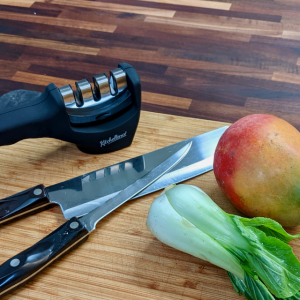The most basic tools of the chef are their knives. Here is a “How To” video that will help you make the best decisions on the knives you need. Chef Leander will also demonstrate how to sharpen them and how to accomplish basic cutting techniques.
Kitchen Knives: Sharpening and Cutting
The most basic of all kitchen tools are your knives. Chef Leander explains the chopping knife and the fillet knife and when to use each. Chef Leander also demonstrates the use of a superb, inexpensive knife sharpener. Never struggle with dull knives again.
Share by Email
Print Recipe
Add to Favorites
Equipment
Ingredients
- 1 small bok choy
- 1 handful spinach
- 1 red mango
Instructions
- A sharp knife makes cooking so much easier and safer. If you are using the sharpener from our website, it is super easy to keep a sharp edge on your knife.Hold the sharpener in your left hand. Put the knife in the groove furthest to the left. Without adding pressure to the knife, drag the knife from heal to tip, through the groove. Do this seven times, then carefully wipe the blade to remove any shavings. Repeat on the middle groove, and finally on the right hand groove. Then be careful. At this point they will be sharper than usual. A nice feature of this knife sharpener is that the sharpening stones are removable, so, for you lefties, you can turn the device around for ergonomic comfort.
- Chiffonade makes a great impression with leafy vegetables or herbs. You often see it with basil, especially on top of a pizza or bruschetta. First practice on the bok choy, slicing thin, horizontal slices off the plant.
- To chiffonade something with separate leaves, like spinach or basil, stack the leaves with stems all going the same direction. Roll the leaves up like a cigar and then slice thinly across the roll.
- The easiest way to serve mango is to "turtle" it with a fillet knife. Cut the mango "cheeks" away from the large seed in the middle. Then you can get the last bit of fruit from around the outside of the seed. Finally, gently the fleshy cheeks in a cross hatch pattern, being careful not to cut through the skin. If you turn the skin inside out, the mango will "turtle." Try it and you'll see where the name came from. You can use your fillet knife to separate the mango from the skin. Often it doesn't last that long as a turtled mango is also great for eating right from the rind, like burying your face in a thick juicy slice of watermelon.
Support us at PatreonPatreon.com/chefleander
Don't miss a single recipe ! ! !Subscribe to our YouTube channel!
To purchase the knife sharpener used in this How-To video, please click HERE!
NOTICE: Small Kitchen BIG TASTE is an Amazon Associate and, as such, we earn from your qualifying purchases. Any item you purchase once you click on an image on our “Store” page supports Small Kitchen BIG TASTE. We appreciate it when you shop in our store and help us continue to put out delicious content.


 We promise:
We promise: